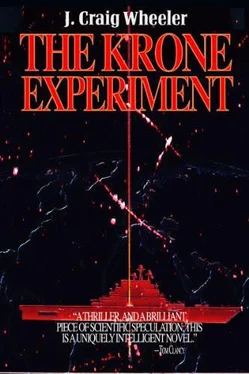A brazen honk snapped her eyes open. She stood for a moment trying to sense if she had actually fallen asleep on her feet. Then she focused on the cab parked on the far side of the street. She gave a quick salute to the driver and proceeded down the steps where she stopped to push the walk/ wait button. As the flash of red and yellow lights signaled a halt to the flow of traffic, she crossed to the taxi and climbed in the rear from the driver’s side.
The driver cocked an ear and Danielson mumbled, “Airport—Eastern shuttle.”
On the plane she tried to practice what she would say to Isaacs. Every time she began to assemble her excited thoughts into coherent English sentences, the words would drift and dissolve as her brain fought to sleep. Back in her office in the Langley headquarters she dropped her briefcase on her desk and, still standing, punched the phone for Isaacs’ office.
“Yes, Miss Kate?” Isaacs fingered the intercom in answer to the buzz.
“Pat Danielson, sir. On the phone.”
“Put her on the line,” Isaacs said, reaching for his telephone. “Hello, Pat? Isaacs, here.”
“We’ve completed the analysis on the periodic seismic signal,” Danielson reported. “We’ve got something big, but I don’t know what.” She sounded excited, only an occasional slurred word indicated fatigue.
Isaacs looked at his watch. “It’s four-thirty now, do you want to talk this afternoon, or wait until tomorrow?”
“Well, I thought you might not be free until tomorrow, but I’d rather get it off my chest. That might help me get some rest tonight. I’ve lived with the computer here and at the Cambridge Research Lab the last week and haven’t had much sleep. I could at least give you the bottom line, then we could go into detail tomorrow sometime, after I’ve had a good night’s sleep.”
“Okay, come on up.” Isaacs buzzed Kathleen to show Danielson in on her arrival and cleaned his desk of the latest summaries concerning the new Russian laser being readied for launch at Tyuratam.
Danielson arrived two minutes later. She looked haggard, but an intensity burned in her eyes. She dropped into the proffered chair, took a deep breath, and held it momentarily before exhaling slowly through pursed lips.
Isaacs waited for her to compose herself. Danielson’s mind spun with the reams of data she’d lived with over the last few days as she endeavored to decide where to begin.
“It’s not a surface effect,” she blurted out. “In places we can clearly track it from the mantle to the core. It then seems to head on back to the surface. A scattered wave would have an attenuated amplitude. This grows in strength as it leaves the core and passes into the mantle.”
“Does it move between two fixed points?” inquired Isaacs, already calculating the surveillance apparatus that could be used once a location was specified.
“On the contrary,” replied Danielson, destroying that train of thought. “At first it seemed to move around randomly although confined to certain latitudes. It’s too weak to follow continuously and it seemed to be taking arbitrary trajectories.
“I racked my brain trying to find a systematic effect that would tie all the data together. I only hit upon it late last night and finished working it out this morning. The path is fixed all right, but not to the Earth.”
Isaacs’ brows rose slightly in surprise. He didn’t speak but fixed his gaze on Danielson as he waited for her to continue.
“At first I thought it always pointed in the same direction with respect to the Sun. Not at the Sun, but at a fixed angle to it. But that wasn’t quite it, so I tried a position fixed to the distant stars and that fits like a glove, as nearly as I can tell.”
“Aaah, wait a minute,” Isaacs leaned forward on his desk and clasped his hands. “Run that by me again.”
“Okay,” Danielson pointed her left index finger at the ceiling and moved her right index finger in a circle around it, pointed at the floor. “As the Earth rotates exactly once on its axis, marking a sidereal day, a given point on its surface will fall on the line of motion we have determined,” she moved her right finger back and forth past her left, “and a fixed distant star will be directly overhead once more. Because of the Earth’s motion in orbit around the Sun, the interval between times when the Sun is directly overhead, the solar day, is four minutes longer. Sidereal time represents a more basic inertial clock, uncomplicated by the orbit of the Earth, and that is the time this phenomenon keeps.”
“Let me get this straight,” said Isaacs. “You’re claiming that this motion is fixed in space? Just as the axis of the Earth’s rotation points in a fixed direction, towards Polaris?”
“Absolutely.” Danielson gave an assertive nod, which caused a curl to slip down on her forehead. She pushed it back with a gesture that suddenly recalled her femininity to Isaacs, but continued at a professional clip.
“Something moves on a line through the center of the Earth. It always comes up near thirty-three degrees north latitude, goes down through the center of the Earth, and comes out again at thirty-three degrees south latitude. Then it goes back to the center and comes out once again at thirty-three degrees north latitude. But since the Earth rotates and the direction along which it moves is fixed, it never comes up at the same point twice.”
The woman’s fatigue receded as she endeavored to elaborate her argument. She jammed a slim finger onto Isaacs’ desk. “Not only is this trajectory independent of the rotation of the Earth on its axis, it’s also independent of the motion of the Earth around the Sun. We have good data now spanning three months. In that time the Earth has moved one quarter of the way around the Sun in its orbit, an angle of ninety degrees. Yet the seismic trajectory has pointed to the same direction in space, a point somewhat to the north and midway between the constellations of Gemini and Cancer. If you extend the line of motion through the Earth’s center and out the other side, it intersects the sky at a point just south of the constellation of Capricorn.”
Danielson leaned back and looked out the window over Isaacs’ shoulder, as she sought an analogy.
“It’s as if there were a string tied at two opposite points in space, Cancer and Capricorn, and passing through the center of the Earth. That string intersects a different point on the Earth’s surface every second as the Earth rotates, but the direction in which the string leads is independent of the rotation of the Earth on its axis or its revolution in orbit about the Sun.”
Isaacs and Danielson stared at each other and then diverted their gazes to random points in the room. Danielson, convinced of the certainty of her conclusions, nevertheless abandoned herself to retracing mentally the steps she had taken over the last few days. She hadn’t the mental energy presently to contemplate the impact of her efforts. Isaacs’ thoughts took two tracks simultaneously, trying to absorb the significance of the raw conclusions just presented and beginning to catalog the possibilities for weakness or errors in the analysis leading to those conclusions.
When he spoke, Isaacs took a middle ground, that of attempting to elicit key facts. “Tell me more about the nature of the signal itself. How close to the surface does it get? What other characteristics does it have?”
Danielson leaned back and massaged her eyes with thumb and index finger while she replied, “Pinning down the position at a given instant is difficult because of the weak signal.” She removed her hand from her face and looked intently at Isaacs. “Our latest estimate of the period is eighty and a half minutes, give or take a few seconds. We don’t get a signal from the mantle, but then we pick it up as it proceeds back toward the core. There is also difficulty in estimating the propagation velocity without accurate positions, but it seems to pick up speed as it approaches the core of the Earth. That is crudely consistent with the behavior of an ordinary sound wave since the sound velocity goes up in the hotter parts of the core. That’s about the only thing it does like an ordinary seismic wave.”
Читать дальше











